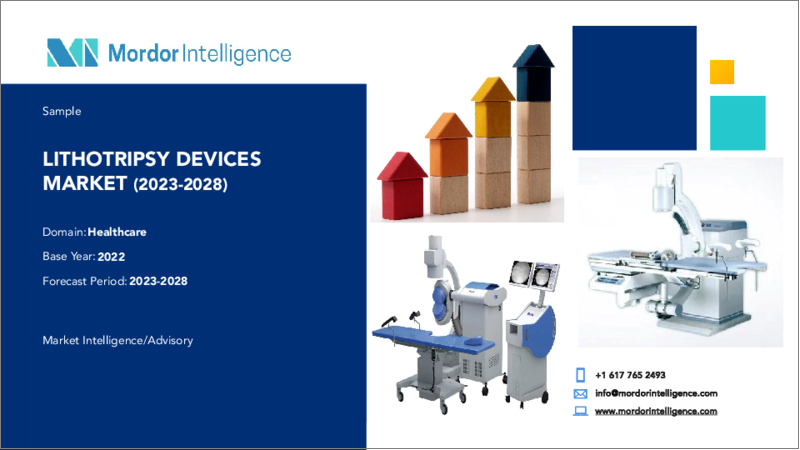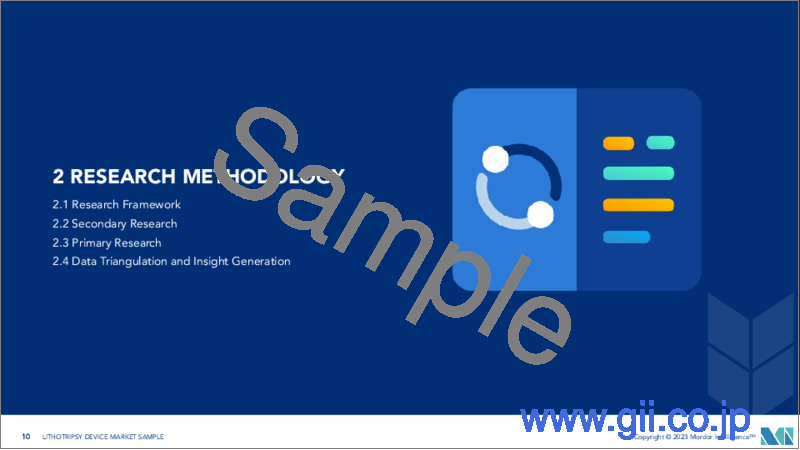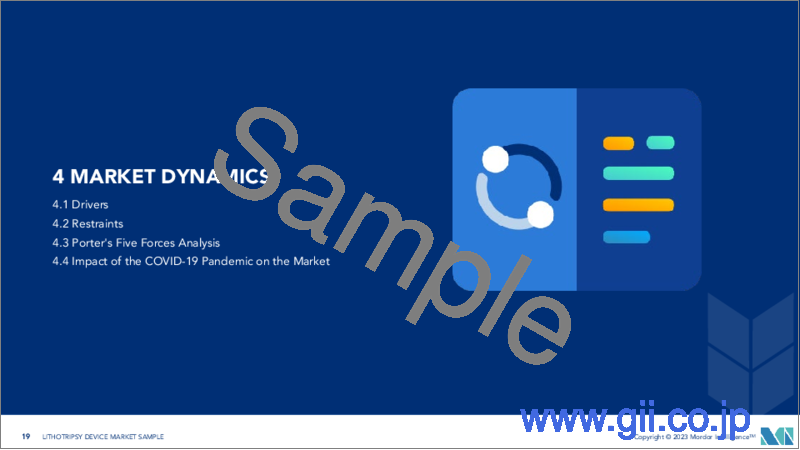|
|
市場調査レポート
商品コード
1197438
結石破砕装置市場- 成長、動向、予測(2023年-2028年)Lithotripsy Device Market - Growth, Trends, and Forecasts (2023 - 2028) |
||||||
|
● お客様のご希望に応じて、既存データの加工や未掲載情報(例:国別セグメント)の追加などの対応が可能です。 詳細はお問い合わせください。 |
|||||||
| 結石破砕装置市場- 成長、動向、予測(2023年-2028年) |
|
出版日: 2023年01月23日
発行: Mordor Intelligence
ページ情報: 英文 120 Pages
納期: 2~3営業日
|
- 全表示
- 概要
- 目次
世界の結石破砕装置市場は、2021年に16億7000万米ドルと評価され、2027年には20億3000万米ドルに達すると予測され、予測期間2022-2027年にCAGR5.5%を記録しています。
この市場は主に、尿路結石の発生率の増加、体外衝撃波結石破砕術の件数の増加、意識の高まりと結びついた技術的進歩によって牽引されています。COVID-19の大流行は、結石破砕装置市場に深刻な影響を与えました。COVID-19に感染した患者を管理するために麻酔科医が必要となり、そのため選択的手術から手を引かなければならなくなったからです。COVID-19に感染した患者を管理するために麻酔科医が必要となり、待機手術から手を引かなければならなかったからです。泌尿器科の患者に使用するベッド数を減らして、新しいCOVID-19病棟のための専用ベッドと人員を確保しなければならなかったのです。また、病院内の汚染によって、選択手術の患者を感染させないようにする必要もあっています。最も重要なことは、泌尿器科の観点から、残った泌尿器科の医療スタッフのほとんどが、新しくできたCOVID-19病棟の感染患者管理に完全に専念するようになったことです。したがって、COVID-19患者プールの増加と選択的手術の減少が2020年の市場に影響を及ぼしたのです。
尿路結石症は一般的な泌尿器科の問題であり、世界的に医療制度に大きな負担を与えています。これは末期腎不全のリスク上昇と関連しており、結石破砕装置の需要を促進しています。欧州泌尿器科学会によると、2019年、尿路結石の有病率は1%から20%とばらつきがあります。カナダ、スウェーデン、米国など、生活水準の高い国では、腎結石の有病率が顕著に高い(10%以上)。地域によっては、過去20年間で37%以上の増加が報告されています。腎結石は末期腎不全のリスクと関連しています。このように、尿路結石症が世界的に増加していることから、安全で有効かつ安価な尿路結石症治療が必要とされています。
長年にわたり、結石破砕術は腎結石の治療法として最も好まれてきました。その主な理由は、比較的安全で、コストが低く、回復時間が短く、患者の転帰が良好であるという利点があるためです。このように、これらすべての要因が市場の成長を後押ししています。
しかし、いくつかの利点とは別に、結石破砕治療に関連するいくつかのリスクも存在します。この治療法は時に内出血を引き起こし、輸血が必要になることがあります。小さな結石の粒子によって尿の流れる通路が塞がれるため、腎臓がダメージを受けるという副作用があります。高血圧などの合併症もあり、これも市場を抑制しています。また、結石破砕の衝撃波による副作用は、高血圧や糖尿病を引き起こすことが多く、場合によっては腎臓の機能量が永久的に失われることもあり、結石破砕装置市場の大きな障壁となっています。
結石破砕装置市場の動向
体外衝撃波結石破砕装置(ESWL)部門が大きな市場シェアを占める見込み
体外衝撃波結石破砕術は、手術を必要としない腎臓や尿管の結石治療法です。高エネルギーの衝撃波を体内に通し、結石を砂粒のように細かく砕きます。体外衝撃波結石破砕装置(ESWL)は、腎臓や尿管の結石の治療に使用されます。この技術は、世界中の医師によって活用されており、最小限の侵襲性、痛みの軽減、入院期間の短縮、回復時間の短縮などの利点から、今後数年間で普及が進むと予想されています。
COVID-19の症例増加に伴い、泌尿器科手術が減少しており、この間、体外衝撃波結石破砕装置(ESWL)の数も減少しているため、市場に若干のマイナスの影響を及ぼすと予想されます。
体外で行う結石破砕術の中で最も一般的なものです。体外衝撃波結石破砕術(ESWL)では、リソトリプターと呼ばれる特殊な機械で音波、X線、超音波などの高エネルギーの衝撃波を発生させ、腎臓結石に当たるまで体内を通過させる。
ESWLは米国で最初に実施されました。しかし、一部の患者さんでは、ESWL後の治療がうまくいかない場合があることが報告されています。ESWLは、腎臓と尿管の一部の結石にのみ使用されます。したがって、すべての結石の種類や部位に適用されるわけではありません。一般的に、この手術は安全で、45分しかかからないため、時間もかからないと考えられています。非侵襲的な処置に対する需要の高まりが、ESWLの採用につながっています。
したがって、腎臓関連疾患の増加や世界の意識の高まりと相まって、予測期間中に市場の成長を拡大させる可能性があります。
結石破砕装置市場、北米が最大シェアを占める
北米では、結石破砕装置市場が予測期間中に成長すると予測されています。慢性腎臓病は、男性よりも女性に多く見られると推定されています。慢性腎臓病の患者数は、世界的に増加していることが分かっています。米国の腎臓病統計は、慢性腎臓病(CKD)および末期腎臓病(ESRD)の負担を伝えています。
COVID-19の大流行により、手術件数が減少した結果、結石破砕装置の使用量が減少し、結石破砕装置市場にマイナスの影響を及ぼしました。また、パンデミックは、サプライチェーンや市場に混乱をもたらすことで生産と需要に直接影響を与え、企業や金融市場にマイナスの影響を及ぼしました。
米国疾病対策予防センターによると、2019年には、約3700万人、すなわち成人人口の7人に1人、15%が慢性腎臓病を患っていると推定されています。腎臓病の症例が増える中、米国では年間5万件以上の結石破砕術が完了しており、結石破砕装置市場の推進に寄与しています。
2019年1月、Shockwave Medical社は、重度に石灰化した冠動脈病変をステント留置用に準備するために設計された冠動脈結石破砕装置の米国での重要な臨床試験を開始しました。この技術は、音波の圧力波を使用して、動脈組織を損傷することなく内膜および内側カルシウムを破砕するもので、同社の事業を拡大し、同国の結石破砕装置市場の推進に役立つと思われます。
したがって、予測期間中、米国における腎結石疾患の高い有病率と治療法を背景に、世界市場における同地域のシェアは大きく伸びると思われます。また、製品の発売、買収、共同研究などが、この地域の市場を促進すると予想されます。
結石破砕装置市場の競合他社分析
結石破砕装置市場は、競争が激しい市場です。結石破砕装置で事業を展開している主な市場プレイヤーは、EDAP TMS、Boston Scientific Corporation、Olympus Corporation、Accuron、DirexGroupなどです。各社は、合併、新製品発表、買収、提携など、特定の戦略的イニシアチブを実施しており、市場での地位強化に役立てています。さらに、企業は予測期間中のポジションを強化するために、結石破砕装置のアプリケーションの増加にも注力しています。
その他の特典
- エクセル形式の市場予測(ME)シート
- アナリストによる3ヶ月間のサポート
目次
第1章 イントロダクション
- 調査の前提条件と市場の定義
- 調査対象範囲
第2章 調査手法
第3章 エグゼクティブサマリー
第4章 市場力学
- 市場概要
- 市場促進要因
- 尿路結石症の負担の増加
- 体外衝撃波結石破砕術の施行件数の増加
- 低侵襲手術の技術的進歩
- 市場抑制要因
- 結石破砕術に関連する副作用
- 結石除去のための代替治療法の利用可能性
- ポーターのファイブフォース分析
- 新規参入業者の脅威
- 買い手/消費者の交渉力
- 供給企業の交渉力
- 代替品の脅威
- 競争企業間の敵対関係
第5章 市場セグメンテーション(金額ベース市場規模:百万米ドル)
- タイプ別
- 体外衝撃波結石破砕装置
- 体内結石破砕装置
- レーザー結石破砕装置
- 電気油圧式結石破砕装置
- 超音波結石破砕装置
- 空気圧(バリスティック)式結石破砕装置
- アプリケーション別
- 腎臓結石
- 尿管結石
- 膵臓結石
- 胆管結石
- エンドユーザー別
- 病院
- 外来手術センター
- その他のエンドユーザー
- 地域別
- 北米
- 米国
- カナダ
- メキシコ
- 欧州
- ドイツ
- 英国
- フランス
- イタリア
- スペイン
- その他欧州
- アジア太平洋地域
- 中国
- 日本
- インド
- オーストラリア
- 韓国
- その他アジア太平洋地域
- 中東地域
- GCC
- 南アフリカ
- その他の中東地域
- 南米
- ブラジル
- アルゼンチン
- その他の南米地域
- 北米
第6章 競合情勢
- 企業プロファイル
- EDAP TMS
- Electro Medical Systems SA(Boston Scientific Corporation)
- Olympus Americas
- Dornier MedTech
- Becton, Dickinson, and Company
- Storz Medical AG
- Cook Medical LLC
- Walz Elektronik GmbH
- Novamedtek
- Elmed Medical Systems
- Karl Storz SE & Co. KG
- Siemens Healthineers AG
- Richard Wolf GmbH
- DirexGroup
- Lumenis
第7章 市場機会と今後の動向
The global lithotripsy device market was valued at USD 1.67 billion in 2021, and it is expected to reach USD 2.03 billion by 2027, registering a CAGR of 5.5% during the forecast period 2022-2027.
The market is primarily driven by the increasing incidence of urolithiasis, a rise in the number of extracorporeal shock waves lithotripsy procedures, and technological advancements coupled with rising awareness. The COVID-19 pandemic has severely impacted the lithotripsy devices market, as anesthesiologists were needed to manage patients infected with COVID-19 and, therefore, had to withdraw from elective surgery. The number of beds used for urological patients had to be reduced to provide dedicated beds and personnel for the new COVID-19 wards. Also, there was a need to not infect elective patients via hospital contamination. Most importantly, from a urological perspective, most of the residual urological medical staff became entirely dedicated to managing the infected patients on the newly formed COVID-19 ward. Hence, the growing COVID-19 patient pool and lesser number of elective surgeries impacted the market in 2020.
Urolithiasis is a common urologic problem, and it poses a significant burden on the healthcare system globally. It is associated with an increased risk of end-stage renal failure, which is driving the demand for lithotripsy devices. As per the European Association of Urology, in 2019, the prevalence rates for urinary stones varied from 1% to 20%. In countries with a high standard of life, such as Canada, Sweden, or the US, renal stone prevalence is notably high (> 10%). For some areas, an increase of more than 37% has been reported over the last 20 years. It has been associated with an increased risk of end-stage renal failure. Thus, the increasing global prevalence of urolithiasis necessitates safe, efficacious, and affordable treatment for urolithiasis.
Over the years, lithotripsy has become the most preferred method for the treatment of kidney stones, mainly due to the advantage of its relative safety, low cost, less recovery time, and positive patient outcomes. Thus, all these factors are responsible for driving the market's growth.
However, apart from the several advantages, there are several risks associated with the lithotripsy treatment. This treatment sometimes leads to internal bleeding and may need a blood transfusion. It can lead to adverse side effects, where the kidney may get damaged due to blockage in the urine flow passage caused by tiny stone particles. There are complications, such as high blood pressure, which also restrain the market. Also, the adverse effects of lithotripsy shock waves often result in hypertension, diabetes, and, in some cases, permanent loss of functional renal volume, which act as major barriers for the lithotripsy devices market.
Lithotripsy Device Market Trends
Extracorporeal Shock Wave Lithotripsy (ESWL) Devices Segment Expected to Have a Significant Market Share
Extracorporeal shock wave lithotripsy is a technique for treating stones in the kidney and ureter that does not require surgery. Instead, high-energy shock waves are passed through the body and used to break stones into pieces as small as grains of sand. The extracorporeal shock wave lithotripsy devices (ESWL) are used for the treatment of kidney and ureter stones. This technology has been utilized by physicians worldwide and is expected to increase its penetration over the coming years due to the advantages offered, such as minimal invasiveness, reduced pain, shorter hospital stay, and quicker recovery time.
With the growing cases of COVID-19, fewer urology surgeries are being performed, which has also reduced the number of extracorporeal shock wave lithotripsy (ESWL) devices during this time, which is anticipated to have a slight negative impact on the market.
It is the most common lithotripsy performed outside the body. During extracorporeal shock wave lithotripsy (ESWL), a special machine known as lithotripter generates high-energy shock waves such as sound waves, x-rays, or ultrasound, which pass through the body until they hit the kidney stones.
ESWL was first performed in the US. However, it has been reported that some patients may not experience a successful outcome following ESWL. ESWL is only used in selected stones in the kidney and ureter. Therefore, it does not apply to all stone types or locations. Generally, this procedure is considered safe and less time-consuming as it takes only 45 minutes to perform. The growing demand for non-invasive procedures is leading to the adoption of ESWL.
Hence, the increasing number of kidney-related disorders, coupled with rising awareness across the globe, are likely to augment the market growth over the forecast period.
North America Holds the Largest Share of the Lithotripsy Device Market
In North America, the lithotripsy devices market is projected to witness growth over the forecast period. Chronic kidney diseases are estimated to be more common in women than men. The number of chronic kidney diseases is found to be increasing globally. Kidney disease statistics for the US convey the burden of chronic kidney disease (CKD) and end-stage renal disease (ESRD).
The COVID-19 pandemic has had a negative impact on the lithotripsy devices market due to the reduced number of surgeries being performed, resulting in reduced usage of the devices. The pandemic also affected the market by directly affecting production and demand by creating supply chain and market disruptions and financially impacting firms and financial markets negatively.
According to the Centers for Disease Control and Prevention, in 2019, around 37 million people, i.e., 1 out of every 7, or 15% of the adult population, were estimated to have chronic kidney diseases. With the increasing cases of kidney diseases, over 50,000 lithotripsy procedures are completed annually in the US, which helps in driving the lithotripsy devices market.
In January 2019, Shockwave Medical launched a US pivotal trial for its coronary lithotripsy device, designed to prepare heavily calcified coronary lesions for stenting. This technology uses sonic pressure waves to fracture intimal and medial calcium without damaging arterial tissue, which is likely to expand the company's business and help in driving the lithotripsy devices market in the country.
Hence, during the forecast period, the region's share of the global market is likely to grow significantly, owing to the high prevalence and the treatments of kidney stone disease in the US. Also, product launches, acquisitions, and collaborations are expected to promote the regional market.
Lithotripsy Device Market Competitor Analysis
The lithotripsy device market is competitive. The key market players operating in lithotripsy devices are EDAP TMS, Boston Scientific Corporation, Olympus Corporation, Accuron, and DirexGroup, among others. The companies are implementing certain strategic initiatives, such as mergers, new product launches, acquisitions, and partnerships, which help them strengthen their market positions. Furthermore, companies are also focusing on increasing the applications of lithotripsy devices to strengthen their positions over the forecast period.
Additional Benefits:
- The market estimate (ME) sheet in Excel format
- 3 months of analyst support
TABLE OF CONTENTS
1 INTRODUCTION
- 1.1 Study Assumptions and Market Definition
- 1.2 Scope of the Study
2 RESEARCH METHODOLOGY
3 EXECUTIVE SUMMARY
4 MARKET DYNAMICS
- 4.1 Market Overview
- 4.2 Market Drivers
- 4.2.1 Increasing Burden of Urolithiasis
- 4.2.2 Rise in Number of Extracorporeal Shock Wave Lithotripsy Procedures
- 4.2.3 Technological Advancements in Minimally Invasive Surgeries
- 4.3 Market Restraints
- 4.3.1 Adverse Effects Associated with Lithotripsy
- 4.3.2 Availability of Alternative Treatments for Stone Removal
- 4.4 Porter's Five Forces Analysis
- 4.4.1 Threat of New Entrants
- 4.4.2 Bargaining Power of Buyers/Consumers
- 4.4.3 Bargaining Power of Suppliers
- 4.4.4 Threat of Substitute Products
- 4.4.5 Intensity of Competitive Rivalry
5 MARKET SEGMENTATION (Market Size by Value - USD million)
- 5.1 By Type
- 5.1.1 Extracorporeal Shock Wave Lithotripsy Devices
- 5.1.2 Intracorporeal Lithotripsy Devices
- 5.1.2.1 Laser Lithotripsy Devices
- 5.1.2.2 Electrohydraulic Lithotripsy Devices
- 5.1.2.3 Ultrasonic Lithotripsy Devices
- 5.1.2.4 Pneumatic (Ballistic) Lithotripsy Devices
- 5.2 By Application
- 5.2.1 Kidney Stones
- 5.2.2 Ureteral Stones
- 5.2.3 Pancreatic Stones
- 5.2.4 Bile Duct Stones
- 5.3 By End User
- 5.3.1 Hospitals
- 5.3.2 Ambulatory Surgical Centers
- 5.3.3 Other End Users
- 5.4 Geography
- 5.4.1 North America
- 5.4.1.1 US
- 5.4.1.2 Canada
- 5.4.1.3 Mexico
- 5.4.2 Europe
- 5.4.2.1 Germany
- 5.4.2.2 UK
- 5.4.2.3 France
- 5.4.2.4 Italy
- 5.4.2.5 Spain
- 5.4.2.6 Rest of Europe
- 5.4.3 Asia-Pacific
- 5.4.3.1 China
- 5.4.3.2 Japan
- 5.4.3.3 India
- 5.4.3.4 Australia
- 5.4.3.5 South Korea
- 5.4.3.6 Rest of Asia-Pacific
- 5.4.4 Middle-East
- 5.4.4.1 GCC
- 5.4.4.2 South Africa
- 5.4.4.3 Rest of Middle-East
- 5.4.5 South America
- 5.4.5.1 Brazil
- 5.4.5.2 Argentina
- 5.4.5.3 Rest of South America
- 5.4.1 North America
6 COMPETITIVE LANDSCAPE
- 6.1 Company Profiles
- 6.1.1 EDAP TMS
- 6.1.2 Electro Medical Systems SA (Boston Scientific Corporation)
- 6.1.3 Olympus Americas
- 6.1.4 Dornier MedTech
- 6.1.5 Becton, Dickinson, and Company
- 6.1.6 Storz Medical AG
- 6.1.7 Cook Medical LLC
- 6.1.8 Walz Elektronik GmbH
- 6.1.9 Novamedtek
- 6.1.10 Elmed Medical Systems
- 6.1.11 Karl Storz SE & Co. KG
- 6.1.12 Siemens Healthineers AG
- 6.1.13 Richard Wolf GmbH
- 6.1.14 DirexGroup
- 6.1.15 Lumenis




